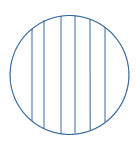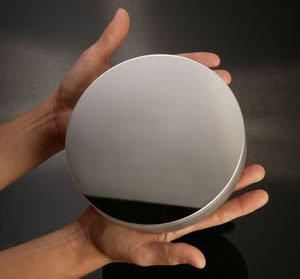p: (262) 548-1155
e: sales@advancedoptics.com
REQUEST A QUOTE
Woman Owned Small Business
SELECTING AN OPTICAL MIRROR
» For sales and capabilities please visit our main optical mirror page.
Optical mirrors are used in a wide variety of applications including aerospace, military and commercial avionics, scientific and medical instrumentation, academics and research, as well as industrial applications. Front surface optical mirrors, also known as first surface optical mirrors, reflect light directly from a metallic coating, which is applied to the polished or working surface.
Optical mirrors are polished prior to being coated with a reflective coating. Surface flatness is specified by how many wavelengths of light the surface deviates from a perfect plane. This is measured using either a test plate or an interferometer. Mirrors are designated as having a commercial flatness (1-3 waves per inch) or a precision flatness (λ/4 , λ/10 or λ/20 ) typically measured at 632.8 nm.
(1/2 wave)
(top view of optical flat)

Perfectly Flat
(top view of optical flat)


How do I choose the correct optical mirror?
A good understanding of your mirror requirements is essential in reducing costs. For instance, the application of the optical mirror will determine which grade of mirror is appropriate. If accuracy is critical, a precision grade is required. The higher the degree of flatness required, the more expensive the mirror. For example, a λ/20 mirror will be several times more expensive than a λ/4 mirror.
In addition, the material used to manufacture the optical mirror is also determined by the application and influences the final cost. Optical mirrors with a lower surface accuracy (λ/4 or even λ/10) can be manufactured using less expensive substrates such as borosilicate glass or N-BK7®. Mirrors polished to a higher degree of flatness (λ/20) need to be made from harder and more expensive materials such as fused silica, quartz or ZERODUR®. These materials are necessary to hold a high degree of surface accuracy.
Finally, when choosing the correct optical mirror, it is important to carefully consider the type of coating best suited to your application. Optical mirrors can be coated with a variety of metallic coatings either with or without a protective overcoat. Although bare coatings (without a protective overcoat) can provide a higher reflectivity, they are very soft and scratch easily. Metallic coatings with a protective overcoat are somewhat more robust, however care must still be taken when using or cleaning an optical mirror. The cost of coatings varies greatly and careful consideration should be given to the mirror’s application, its environment and other absolute requirements.
Typical optical coatings include: bare and protected Al, bare and protected Au, enhanced Al (one specifically designed for the visible region of the spectrum and one for the ultraviolet region) and protected Ag. Theoretical reflectivity for these coatings are as follows:

Making the final decision.
Material, accuracy and coating all influence the cost of an optical mirror. Determining the best optical mirror for your application will require you to consider the following:
- How will the mirror be used? Determine what conditions, such as temperature and exposure to abrasion, the mirror will be subjected to.
- Optical Material selection. Borosilicate glass offers low expansion and resistance to thermal shock and makes a good all-around mirror substrate. Borosilicate glass is the least expensive of the substrates typically used to fabricate optical mirrors. However, if a high degree of accuracy is required, a more expensive material such as fused silica or ZERODUR® may be required.
- Determine the correct accuracy needed for your application. The more accurately the surface is polished, the less light loss and light scatter there will be and therefore the sharper the reflection will be. Accuracy is also determined by the aspect ratio of the part being polished. An aspect ratio of 6:1 is common for precision polished mirrors. However, sometimes this is not acceptable for certain applications. Should this be the case, one needs to be aware that as the part becomes thinner and further away from the standard aspect ratio of 6:1, flatness may be sacrificed.
- Optical Coating selection. When selecting a coating one should consider the wavelength range you are working in and the angle of incidence required. Once this is determined, carefully consider how much (percentage of) reflection is required at the wavelength range and angle of incidence for the application.
- Customization. Optical mirrors can be customized to meet unique requirements. Advanced Optics capabilities allow us to drill precision holes, produce beveled substrates, fabricate custom sizes and shapes and provide custom coatings with fast turnaround.
Have a question? Give us call and tell us about your project. (262) 548-1155
- Optical Mirrors
- AlSiO Economy Optical Mirror
- Bare Al Optical Mirror
- Borosilicate Optical Mirror
- Custom Optical Mirror
- First Surface Optical Mirrors
- Fused Silica Optical Mirror
- Precision Optical Mirror
- ZERODUR® Optical Mirror
- Round Optical Mirrors
- Rectangle Optical Mirrors
- Square Optical Mirrors
- λ/4 Optical Mirrors
- Standard 1" x 1", λ/4 Optical Mirror
- λ/10 Optical Mirrors
- λ/20 Optical Mirrors
- Selecting An Optical Mirror
- Optical Mirror 10 Step Design Chart
- Technical Data: Protected Mirrors
- Technical Data: Unprotected Mirrors
- Optical Mirror Cleaning
- Optical Windows
- Custom Optical Window
- Commercial Grade Optical Window
- Precision Optical Window
- Fused Silica Optical Windows
- N-BK7 Optical Windows
- Viosil Optical Windows
- Borosilicate Optical Windows
- Soda-lime Glass Optical Windows
- UV and IR Optical Windows
- λ/20 Optical Window
- Optical Window 10 Step Design Chart
- Optical Window Technical Information
- Optical Filters
- Dichroic Optical Filters
- Neutral Density Filters
- Colored Glass Absorptive Filters
- Optical Filters Technical Information
- Optical Lenses
- Optical Lenses Convex/Concave Mirror Theory
- Technical Data for Optical Materials
- Corning Fused Silica Data Sheet PDF
- BORO FLOAT Technical Data Sheet PDF
- N-BK7 Technical Data Sheet PDF
- Soda Lime Glass Technical Data Sheet PDF
- Fused Quartz Data Sheet PDF
- Zerodur Technical Data Sheet PDF
- Clearceram(C) Data Sheet PDF
- ULE® Low Expansion Glass Data Sheet PDF
- Viosil Data Sheet PDF
-
P.O. Box 117, Pewaukee, WI 53072-0117, USA
-
(262) 548-1155
Fax (262) 548-1153
